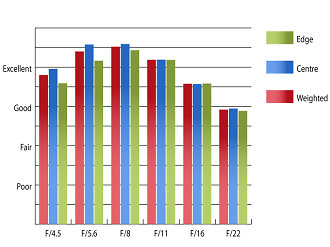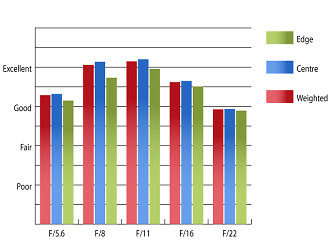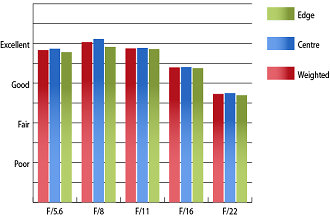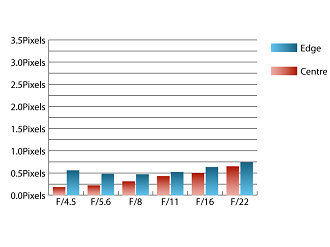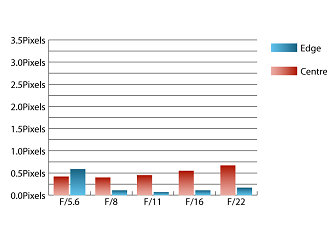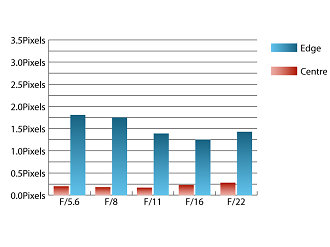Pentax HD FA 150-450mm f/4.5-5.6 ED DC AW Review
Pentax HD PENTAX-D FA 150-450mm f/4.5-5.6 ED DC AW Performance
At 150mm, sharpness is already excellent in the centre of the frame, with performance towards the edges reaching very good levels. Stopping down to f/8 results in outstanding sharpness across the frame at this focal length.
Zooming to 300mm and maximum aperture, sharpness drops to good levels across the frame. Performance improves with stopping down, reaching excellent levels across the frame by f/8.
Finally, at 450mm, sharpness actually increases at maximum aperture and is incredibly consistent across the frame. Here sharpness levels are very good levels across the frame and stopping down to f/8 results in peak performance.
How to read our charts
The blue column represents readings from the centre of the picture frame at the various apertures and the green is from the edges. Averaging them out gives the red weighted column.The scale on the left side is an indication of actual image resolution. The taller the column, the better the lens performance. Simple.
For this review, the lens was tested on a Pentax K-3 using Imatest.
Chromatic aberrations are well controlled between 150mm and 300mm, with fringing increasing dramatically at 450mm. At 450mm fringing exceeds 1.75 pixel widths towards the edges of the frame at maximum aperture, which may become visible, especially in images containing areas of high contrast.
How to read our charts
Chromatic aberration is the lens' inability to focus on the sensor or film all colours of visible light at the same point. Severe chromatic aberration gives a noticeable fringing or a halo effect around sharp edges within the picture. It can be cured in software.Apochromatic lenses have special lens elements (aspheric, extra-low dispersion etc) to minimize the problem, hence they usually cost more.
For this review, the lens was tested on a Pentax K-3 using Imatest.
Falloff of illumination towards the corners of the frame is well controlled. At 150mm and maximum aperture, the corners are 0.4 stops darker than the image centre increasing to a difference of 0.5 stops at 450mm. Visually uniform illumination is achieved with the aperture stopped down to f/8 or beyond.
Distortion is very well controlled at both ends of the zoom range. Imatest detected 0.6% pincushion distortion at 150mm, which decreases to 0.01% pincushion distortion at 450mm. The distortion pattern is uniform across the frame, which should make it relatively easy to apply corrections in image editing software afterwards if absolutely straight lines are necessary.
During testing, this lens proved itself very resistant to flare and contrast levels are good, even when shooting into the light. The deep hood does a good job of shading the lens from extraneous light that may cause issues.
Value For Money
Being priced at around £2000, this lens is priced roughly in line with similar offerings from other manufacturers for their own camera systems.
Sigma's 150-500mm f/5-6.3 DG HSM may make a viable alternative, especially with it sporting a slightly more telephoto reach, at the expense of a slower maximum aperture. Although it lacks weather sealing, it is substantially cheaper, being available for around £600.
Add your message
Please login here or if you've not registered, you can register here. Registering is safe, quick and free.
photodo Stats
428 MTF tests
74 in-depth photodo reviews
100+ users join each day
Help the lens community by reviewing or rating a lens today via our lens search
Latest Lens Reviews
- Chinon 28mm f/2.8 Vintage Lens Review
- Canon EF 70-200mm f/4L IS II USM Lens Review
- Samyang AF 85mm f/1.4 EF Review
- Sigma 70mm f/2.8 DG Macro Art Review
- Samyang AF 24mm f/2.8 FE Review
- Meike 50mm f/1.7 Review
- Tamron 70-210mm f/4 Di VC USD Review
- Lensbaby Burnside 35mm f/2.8 Review
- Asahi Super Takumar 50mm f/1.4 Review
- Asahi Super-Multi-Coated Takumar 135mm f/3.5 Review
